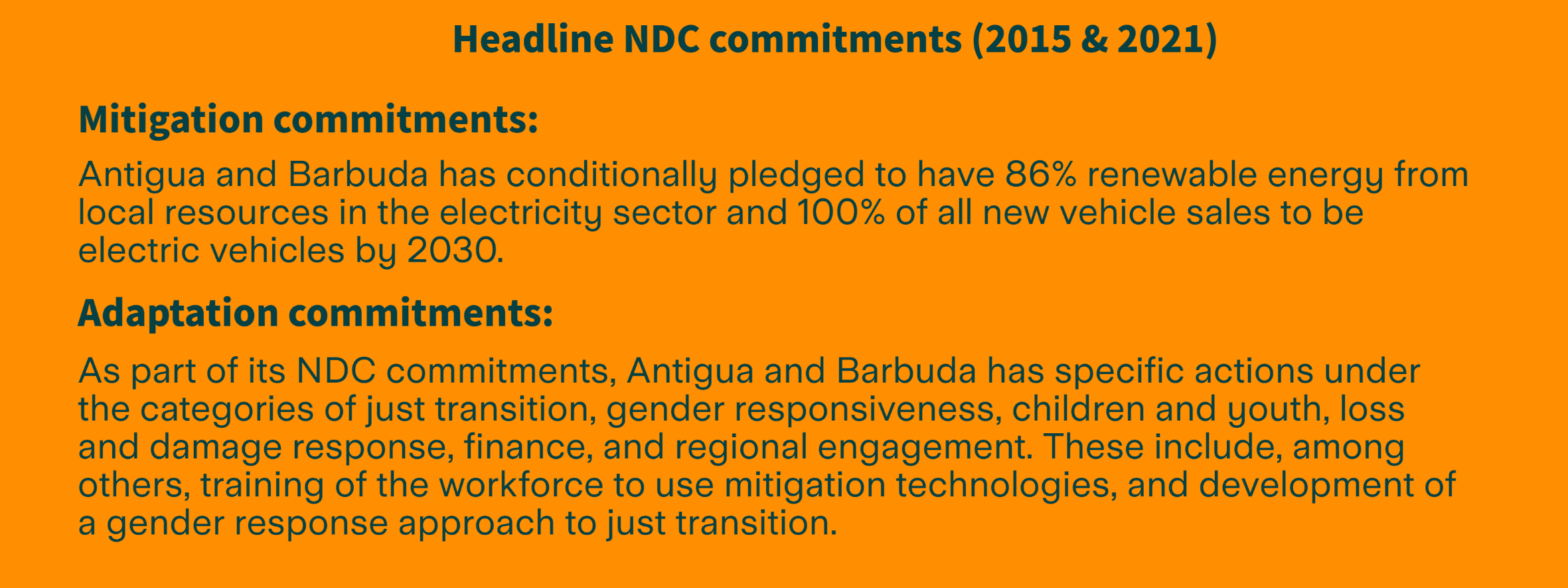Article published on climateactiontransparency.org and reposted with no changes.
“Background
Antigua and Barbuda is a sovereign small island developing State (SIDS) in the Eastern Caribbean that experiences disproportionate levels of risk from natural disasters, including those related to climate change. Since the ratification of the UNFCCC in 1992, Antigua and Barbuda has led, like many other SIDS, from the front in negotiations, and was instrumental in the negotiation process for the 2015 Paris Climate Change Agreement.
Although the greenhouse gas emissions of Antigua and Barbuda are small (0.0015% of global emissions) the country is committed to implementing measures to grow its economy in a low-carbon and sustainable manner. This is reflected in its first nationally determined contribution (NDC) submission in 2016 and its updated NDC of 2021.

ICAT is building capacity in establishing a sustainable national economy-wide greenhouse gas emission projection and mitigation analysis modelling capabilities in Antigua and Barbuda
The Initiative for Climate Action Transparency (ICAT) was established in 2015 at the COP that adopted the Paris Agreement to support implementation of the Agreement’s Enhanced Transparency Framework.
ICAT provides countries with tailored support and practical tools and methodologies to build robust transparency frameworks needed for effective climate action in sync with national development priorities. The projects ICAT supports relate to: building or enhancing transparency systems for mitigation actions; building a monitoring approach for adaptation actions; implementing and further delivering nationally determined contributions; assessing the impacts of policies related to climate action; integrating and/or aggregating climate actions at the subnational level and for non-state actors; and identifying and increasing domestic benefits and synergies from enhanced climate action.
ICAT offers a range of methodologies and tools to assist countries. The Initiative works with over 40 developing countries ranging from large countries, like China, to small islands, such as Antigua & Barbuda.
ICAT is an unincorporated multi-stakeholder partnership steered by the Donor Steering Committee (DSC), conformed by its donors, the Children Investment Fund Foundation (CIFF); Climate Works Foundation (CWF); Germany and Italy, and the UNFCCC Secretariat and UNOPS as ex-officio members. The Initiative is managed by UNOPS on behalf of the DSC. Within UNOPS, the ICAT Secretariat manages ICAT day-to-day activities, coordinating and guiding the work of the implementing partners.
Project Overview
The ICAT project began work in Antigua and Barbuda in 2020. The initiative partnered with the Department of the Environment (DOE) to strengthen the capacity within the country in modelling and projections. The overall project supported the evaluation of the mitigation strategy as outlined in the NDC, beginning with the identification of a suitable modelling tool, a baseline scenario and a thorough assessment of the climate change mitigation policies, programmes, plans and projects. To assist with this project and provide regional guidance and capacity building, the DOE partnered with the Caribbean Cooperative Measurement Reporting and Verification Hub as regional experts.
The project’s initial phase was assessing the available tools and selecting the most suitable ones for Antigua and Barbuda. To undertake this, the scope required for the mitigation assessment was defined by the team and validated by stakeholders. This led to the recommendations of the modelling tools of the Greenhouse Gas Abatement Cost Model (GACMo) and the Low Emissions Analysis Platform to be used in the project.
Once the modelling software was identified, capacity building on the use of the modelling software was organized. Introductory training on the general aspects of mitigation assessment and the use of the two tools was organized. ICAT’s implementing partners provided technical support throughout and particularly on the use of the GACMO model. Twenty-four participants were enrolled in this training.
A second, advanced training of 11 people was organized to delve into the software and develop emission reduction pathways for Antigua and Barbuda. These capacity-building sessions helped improve stakeholders’ capacity in the selected tools and develop an understanding of the process involved in undertaking a mitigation assessment.
As part of the project, the baseline scenario and mitigation assessment were conducted, and relevant reports were developed. The baseline scenario reflected the analysis of historical data and updated information from previous modelling work. This highlighted the projections of the business-as-usual scenario if the existing mitigation policies were not strengthened or new ones implemented. The mitigation scenario highlighted the effects of mitigation actions when compared to the baseline scenario. The mitigation scenarios were an in-depth analysis of the measures included in the NDC and other available data.
The NDC actions and relevant policies were inputted into the models, and individual and combined scenarios were assessed. The main focus of the modelling was on the energy and transport sector, which coincided with the actions in the NDC. The tools made it possible to assess the mitigation actions’ potential emissions reductions and costs.
Special attention was given to the calibration of the model on the modelling base year. Furthermore, actions were modelled as individual and also as aggregated actions to assess the co-benefits when actions are implemented simultaneously.

Conclusion
The ICAT project supported the robust data collection with the national and regional teams collecting data in-country and regionally. The project further highlighted the need for further improvements in the data collection process. A data collection manual was produced, highlighting the types of data required for modelling and possible data sources.
This ICAT project has significantly impacted Antigua and Barbuda’s efforts to implement their NDCs. The project highlights the emission reduction potential and the areas where improvements are required. Stakeholders were engaged throughout the project through various workshops and stakeholder consultations. This included an inception workshop, various consultations with key private and public agencies, a validation workshop and a modelling capabilities workshop where the modelling tools were further displayed. This included a demonstration of how they could be incorporated into daily work routines.
Antigua and Barbuda is preparing its fourth national communication, and it is expected that the capacity developed during this ICAT project will significantly contribute to the development of this report.
Overall, the work undertaken with support from ICAT has made significant contributions to Antigua and Barbuda’s understanding of the expectations of its updated NDC submission. The project has enabled Antigua and Barbuda to identify a baseline scenario, potential GHG emission reductions from mitigation actions and to better understand the interactions between some mitigation actions. It has also helped Antigua and Barbuda identify the areas for improvement as they revise their NDC commitments in the next cycle, and to revise some policies that are critical to the achievement of the NDC targets. Furthermore, the results of this project can also potentially be used by Antigua and Barbuda in developing a robust MRV system, where careful tracking of the progress to the achievement of the NDC can be realized. This will set Antigua and Barbuda well on its way for the reporting requirements of its Biennial Transparency Report.
Future Work
As a next step, ICAT is already supporting Antigua and Barbuda in addressing some of the areas recognized from the project’s first phase. Phase 2 of the ICAT project looks to address some of the gaps in data for the transport sector as identified in Phase 1 of the project. The transport sector is a major contributor to greenhouse gas emissions in Antigua and Barbuda, accounting for more than 50 per cent of the total national greenhouse gas emissions. This next phase is expected to further develop modelling capabilities to assess the impact of mitigation action in the transport sector, particularly the transition to e-mobility, which is one of the key actions of the NDC. Through this second phase, ICAT will further support policymakers in Antigua and Barbuda to be well-equipped with information on the benefits and costs of e-mobility. This will assist in conducting evidence-based policymaking and effectively implementing transport-related projects.”

Comments